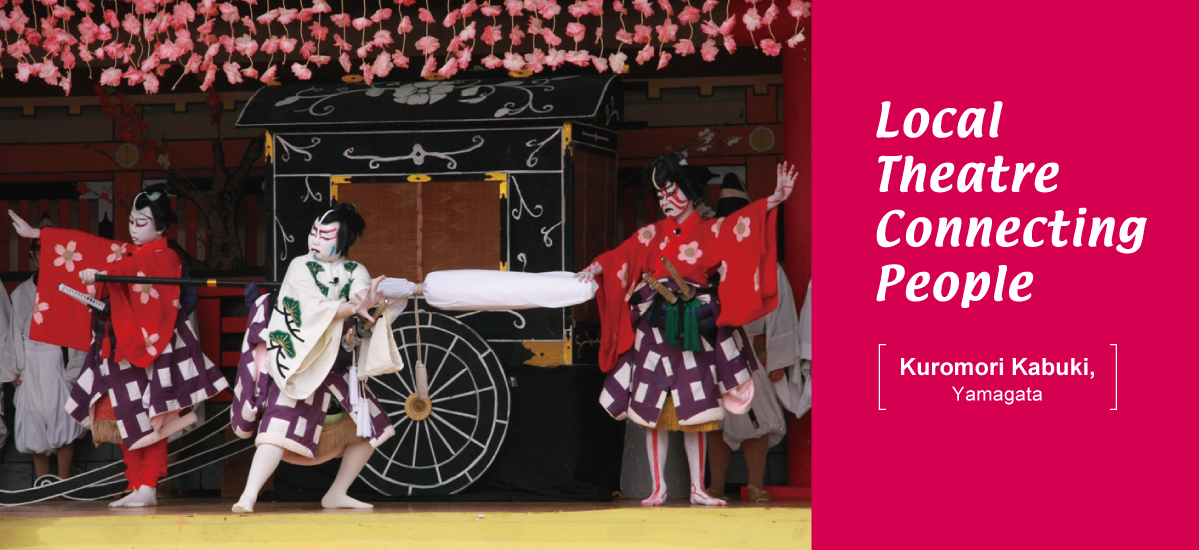

There’s a good reason why Kuromori Kabuki is also known as “Theatre in the Snow”. Performances of this Intangible Folk Cultural Property take place outdoors during one of the coldest months of the year! Snow is a frequent visitor to Kuromori Kabuki, held in snowy Yamagata Prefecture on February 15th and 17th each year.
Text : 村田保子 Yasuko Murata / Photos : 谷口哲 Akira Taniguchi / English Version : Judy Evans
Keyword : Japanese performing arts / Kabuki / Yamagata Prefecture / Kuromori Kabuki / Local Theatre
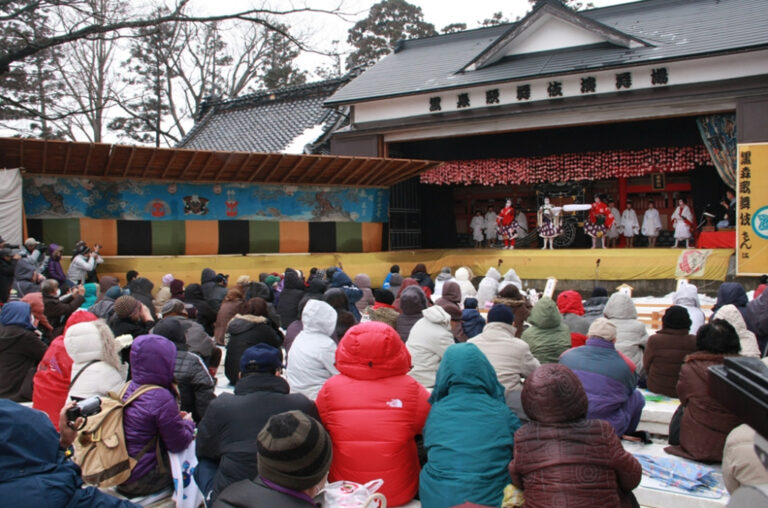
Young and Old Working Together – a Community Effort
From the performers to the backstage and production teams, Kuromori Kabuki is staged entirely by local people, drawing from a population of around 1,300 in the 370 households of Kuromori in Sakata City. Performances traditionally coincided with the old New Year period from Japan’s ancient lunar calendar. Nowadays, the audience is made up of keen kabuki fans from all over Japan, who come here to brave the cold and enjoy the heart-warming spectacle unfolding on the outdoor stage.
“My grandfather performed kabuki here on this stage and so did my father. When I watched them as a small child it seemed natural to me that I would also someday take to the stage. Now, if I don’t get to smell that stage make-up once a year, things just don’t seem right!” laughs Shin’ichi Satō, managing director of the Kuromori Kabuki theatre company. The troupe consists of about forty members of all ages, from seven-year-old actors to ninety-year-old stage hands. Satō san says that the actors aged in their twenties to forties are the driving force of the theatre company.
The traditional Kuromori way is for actors to retire after reaching their mid-forties. At this point they become involved in the management of the theatre, making way for the next generation. Satō san, the current managing director, is himself a former popular lead actor who stepped away from the stage fifteen years ago.
A special unity that spans the generations helps explain why Kuromori Kabuki has continued for so long. “These young guys get along really well together,” says Satō san. “Whenever we’ve been a bit short on actors or stage hands, they call up their old schoolmates and before you know it the numbers in our troupe begin to swell.” As for why young people want to take part in kabuki? “They enjoy drinking after rehearsal!” Satō san is quick to add that there’s a lot to be learnt from interacting with different people of all ages.
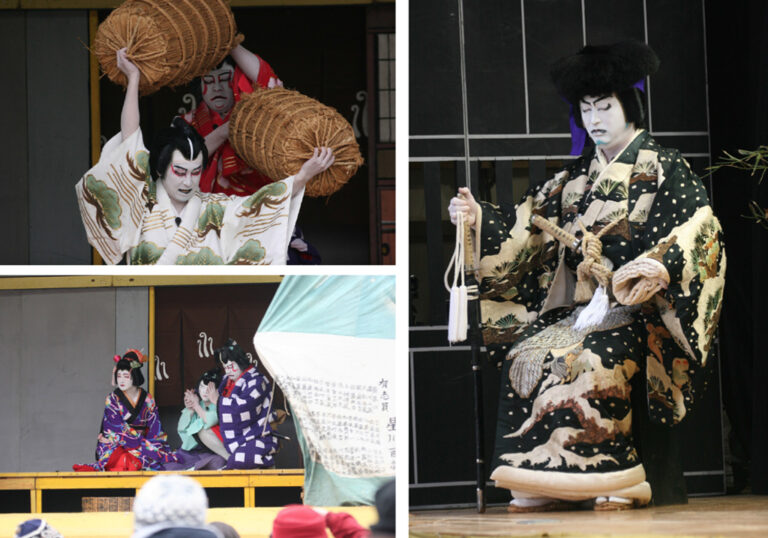
Twenty-four year-old Yasuya Bandō plays the part of Umeōmaru in the celebration scene in Act III of Sugawara Denju Tenarai Kagami. He has been acting for fourteen years now, having made his stage debut at the age of ten. “The applause just makes me feel so happy!” he says. “I’m basically a show-off, so once I’d experienced being on stage, I was hooked.”
Bandō san says that as a child he took to the stage without knowing anything about kabuki. Until he started high school, he found it all a bit embarrassing and couldn’t take it seriously. This changed after being given an important role. He began to feel a sense of the responsibility that came with the role and started practising in earnest. “Once you learn how to deliver the lines properly, it really is fun,” he says.
Kōya Ichikawa (32), who plays the female role of Tonami in the village school scene, says that he starts learning his lines as soon as the roles are announced in summer. Kuromori Kabuki has its own distinctive regional characteristics that differentiate it from mainstream kabuki. Ichikawa san prepares by studying old footage of the plays and practising the movements, as well as researching old-time Edo kabuki.
“Kuromori Kabuki appeals to audiences because of the way we highlight the emotions,” says Ichikawa san. “I’m striving to perfect the aspects that are unique to Kuromori, so as not to spoil the integrity of the traditional performance style.”
New Challenges for Youth Kabuki
The local people’s proactive approach to new challenges is one of the main strengths of this theatre company. Kabuki has been included as part of the curriculum at schools in the Kuromori area since 1998 and each year’s production features a performance by upper-grade students from Kuromori Elementary School. Involvement in the village’s iconic kabuki has helped raise students’ interest in this traditional performing art and has proven to be an effective way to nurture successors.

This may be youth kabuki, but the young performers take it every bit as seriously as the adults do. Up until last year, the children performed Shiranami Go-nin Otoko, a play about a band of thieves and rogues. From this year though, the children will perform a scene within the adults’ play. This year that play is Sugawara Denju Tenarai Kagami and the children are performing the struggle for the carriage scene that opens Act III.
The four 5th and 6th grade students taking the leading roles began training in earnest during the summer vacation of the previous year. One of the 6th grade teachers reported that parents and teachers began to worry that the children’s final performance might bear more resemblance to a school play than true kabuki. However, once the children started one-on-one training with ‘real’ kabuki actors, the young performers’ confidence grew and they became more certain of their roles.
The big day did not go off without a few bumps, though. The children performed their scene amid falling sleet. The stage got wet, one boy slipped and toppled over, and his wig went flying! Nevertheless, the audience loved the scene and responded warmly to the children’s passionate performance. Watching anxiously from the back of the audience, the chairman was all smiles as the scene unfolded, commending the young actors for their skill, in particular their ability to pull off the kabuki postures and movements. The whole arena seemed to become enveloped in an atmosphere of calm as nervous adults and troupe members all visibly relaxed.
Keeping it Local, Keeping it Real
Kuromori Kabuki remains true to its Edo kabuki roots. Ever since Kuromori Kabuki began, they have used the same Edo Period scripts, costumes and wigs. They are committed to performing genuine kabuki, without compromise, which means that only males can go on stage – a rule has never been broken. Women work behind the scenes on hair and costumes, taking charge of wig and costume changes. The actors do their own makeup, but are assisted with dressing.

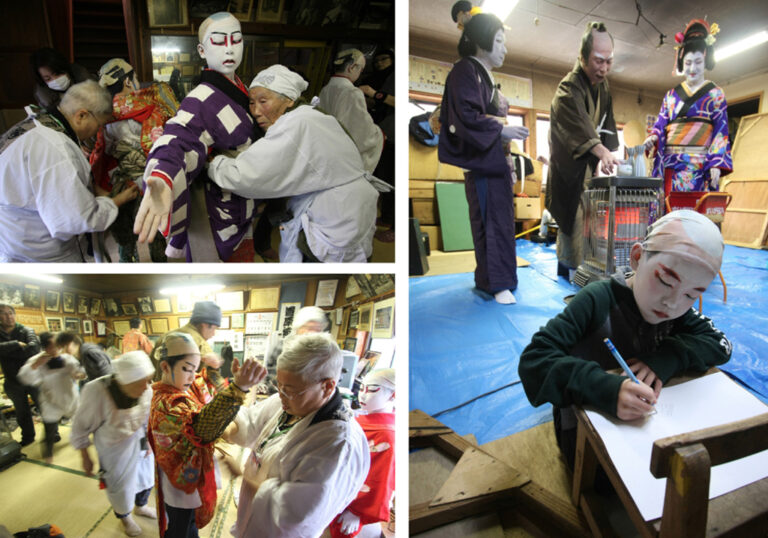
The busiest people on the day of the performance seem to be the women working backstage. According to Chiyoko Nishioka, who has been in charge of hair for thirty-five years, the women work unceasingly from morning till evening, fetching and carrying costumes for more than forty different roles from the storehouse and getting them onto the actors. Just like the actors, those working backstage are expected to be proactive about learning what to do and about taking responsibility for their own roles. Every member of the theatre company participates in this spirit. “There are no teachers or students here – we all teach ourselves how to do the hair and costumes by watching and learning” says Nishioka san.
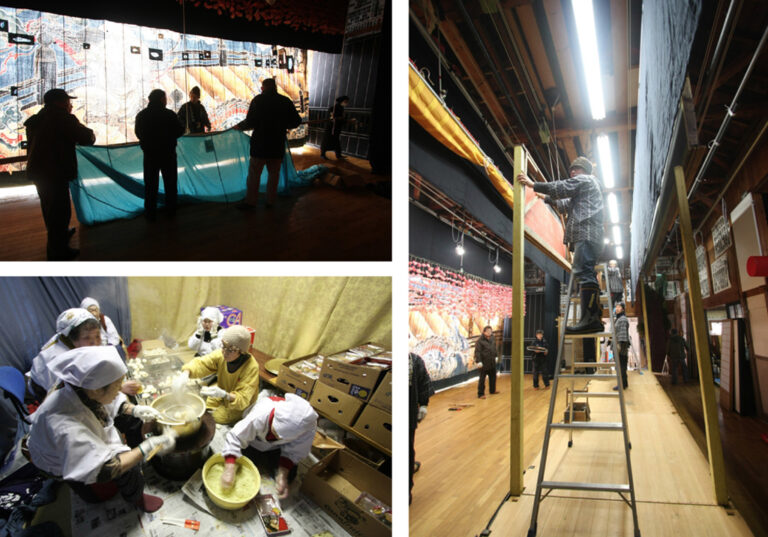
All the locals work hard to make this a really special event. To support the production, mothers and local women’s groups contribute in a number of ways, such as providing kabuki-bentō (temple-style vegetarian boxed meals) and local specialities such as go-jiru miso soup and ama-zake, a traditional sweet, fermented rice drink.
On the big day, every nook and cranny of Kuromori Hie Shrine is filled with true passion and enthusiasm. Coming here and watching the performance, I was able to see how completely absorbed the young people are in their kabuki. And what’s more, the performers’ passion is contagious, sweeping the audience up in the spirit of local kabuki. The play continues into the evening. By the final curtain, the sleet has given way to snow.
Lots will be drawn at the Tayu Furumai ritual in March to determine which play will be performed next year. Until then, the curtain, like the snow, gently falls on this year’s production.
(This article was first published in 2013.)
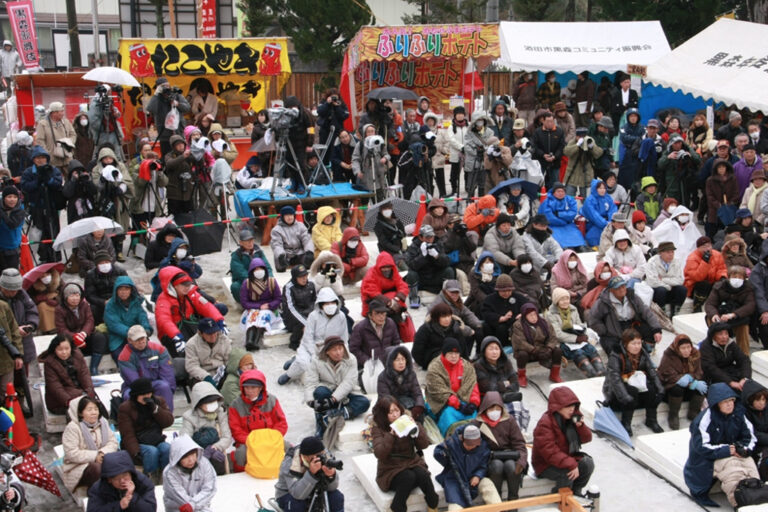
Kuromori Kabuki
Venue: Kuromorihie Shrine, Muranaka-47 Kuromori, Sakata City, Yamagata Prefecture
Enquiries: Sakata City Board of Education, Social Education and Culture Division, Cultural Properties Section
Phone: 0234-24-2994








